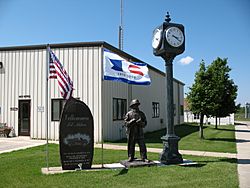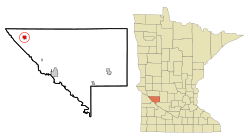Milan, Minnesota facts for kids
Quick facts for kids
Milan
|
|
|---|---|

Milan's City Hall
|
|
| Motto(s):
"Norwegian Capital U.S.A."
|
|

Location of Milan, Minnesota
|
|
| Country | United States |
| State | Minnesota |
| County | Chippewa |
| Area | |
| • Total | 0.70 sq mi (1.80 km2) |
| • Land | 0.68 sq mi (1.77 km2) |
| • Water | 0.01 sq mi (0.03 km2) |
| Elevation | 1,004 ft (306 m) |
| Population
(2020)
|
|
| • Total | 428 |
| • Density | 627.57/sq mi (242.42/km2) |
| Time zone | UTC-6 (Central (CST)) |
| • Summer (DST) | UTC-5 (CDT) |
| ZIP code |
56262
|
| Area code(s) | 320 |
| FIPS code | 27-42146 |
| GNIS feature ID | 2395319 |
Milan (pronounced MY-luhn) is a small city in the state of Minnesota, United States. It's located in the northwest part of Chippewa County. In 2020, about 428 people lived there. Milan is known as the "Norwegian Capital U.S.A." because many people with Norwegian heritage live there.
Contents
Milan's History
Milan was officially planned out in 1880. It became an incorporated city in 1893. This means it was given its own local government. The city was named after the famous city of Milan, Italy. A post office has been open in Milan since 1879.
Geography and Location
Milan is located in a beautiful part of Minnesota. The city covers a total area of about 1.80 square kilometers (0.70 square miles). Most of this area, about 1.77 square kilometers (0.68 square miles), is land. A small part, about 0.03 square kilometers (0.01 square miles), is water.
Main Roads in Milan
Several important roads pass through Milan. These include U.S. Route 59 and Minnesota State Highway 7. These two highways share the same path for a bit. Minnesota State Highway 40 is another main road in the community. These roads help people travel in and out of Milan.
Milan's Climate
Milan experiences a range of weather throughout the year. The warmest month is usually July, and the coldest is January. The area gets a good amount of rain, especially in the summer. Snowfall is common during the winter months.
| Climate data for Milan, Minnesota (1991–2020 normals, extremes 1893–present) | |||||||||||||
|---|---|---|---|---|---|---|---|---|---|---|---|---|---|
| Month | Jan | Feb | Mar | Apr | May | Jun | Jul | Aug | Sep | Oct | Nov | Dec | Year |
| Record high °F (°C) | 66 (19) |
64 (18) |
85 (29) |
97 (36) |
106 (41) |
106 (41) |
113 (45) |
107 (42) |
108 (42) |
95 (35) |
82 (28) |
73 (23) |
113 (45) |
| Mean daily maximum °F (°C) | 23.9 (−4.5) |
28.9 (−1.7) |
42.1 (5.6) |
58.7 (14.8) |
72.4 (22.4) |
81.4 (27.4) |
84.9 (29.4) |
82.4 (28.0) |
76.0 (24.4) |
60.8 (16.0) |
43.0 (6.1) |
29.0 (−1.7) |
57.0 (13.9) |
| Daily mean °F (°C) | 14.1 (−9.9) |
18.8 (−7.3) |
32.1 (0.1) |
46.7 (8.2) |
59.9 (15.5) |
69.7 (20.9) |
73.0 (22.8) |
70.5 (21.4) |
63.2 (17.3) |
49.2 (9.6) |
33.5 (0.8) |
20.0 (−6.7) |
45.9 (7.7) |
| Mean daily minimum °F (°C) | 4.4 (−15.3) |
8.7 (−12.9) |
22.1 (−5.5) |
34.7 (1.5) |
47.4 (8.6) |
58.0 (14.4) |
61.2 (16.2) |
58.7 (14.8) |
50.3 (10.2) |
37.5 (3.1) |
24.0 (−4.4) |
10.9 (−11.7) |
34.8 (1.6) |
| Record low °F (°C) | −38 (−39) |
−42 (−41) |
−32 (−36) |
−3 (−19) |
16 (−9) |
23 (−5) |
36 (2) |
30 (−1) |
14 (−10) |
−1 (−18) |
−21 (−29) |
−35 (−37) |
−42 (−41) |
| Average precipitation inches (mm) | 0.77 (20) |
0.74 (19) |
1.44 (37) |
2.50 (64) |
3.14 (80) |
3.89 (99) |
4.07 (103) |
3.71 (94) |
2.77 (70) |
2.43 (62) |
1.14 (29) |
0.77 (20) |
27.37 (695) |
| Average snowfall inches (cm) | 9.5 (24) |
10.1 (26) |
9.2 (23) |
6.0 (15) |
0.1 (0.25) |
0.0 (0.0) |
0.0 (0.0) |
0.0 (0.0) |
0.0 (0.0) |
1.2 (3.0) |
6.3 (16) |
8.6 (22) |
51.0 (130) |
| Average precipitation days (≥ 0.01 in) | 5.5 | 5.0 | 6.1 | 8.5 | 10.4 | 10.7 | 8.8 | 8.3 | 8.4 | 7.7 | 4.9 | 5.3 | 89.6 |
| Average snowy days (≥ 0.1 in) | 5.7 | 5.1 | 3.5 | 1.8 | 0.0 | 0.0 | 0.0 | 0.0 | 0.0 | 0.8 | 2.9 | 5.3 | 25.1 |
| Source: NOAA | |||||||||||||
Population and People
The number of people living in Milan has changed over the years. Here's how the population has grown and shrunk:
| Historical population | |||
|---|---|---|---|
| Census | Pop. | %± | |
| 1880 | 28 | — | |
| 1900 | 396 | — | |
| 1910 | 468 | 18.2% | |
| 1920 | 590 | 26.1% | |
| 1930 | 548 | −7.1% | |
| 1940 | 624 | 13.9% | |
| 1950 | 561 | −10.1% | |
| 1960 | 482 | −14.1% | |
| 1970 | 427 | −11.4% | |
| 1980 | 417 | −2.3% | |
| 1990 | 353 | −15.3% | |
| 2000 | 326 | −7.6% | |
| 2010 | 369 | 13.2% | |
| 2020 | 428 | 16.0% | |
| U.S. Decennial Census | |||
Since the mid-2000s, Milan has become a new home for many people from Micronesia. These people can move to the United States easily because of a special agreement between their countries. Many of these new residents are from the Chuukese ethnic group. It's thought that about one-third to one-half of Milan's population is now Micronesian.
Milan's Population in 2010
In 2010, the city of Milan had 369 people living in 150 households. A household is a group of people living together in one home. About 90 of these households were families.
The average number of people in each household was 2.46. For families, the average size was 3.22 people. About 29.3% of households had children under 18 living with them.
The average age of people in Milan was 37.5 years old. About 24.1% of residents were under 18. Also, 18.4% of the people were 65 years old or older. The population was made up of 53.1% males and 46.9% females.
See also
 In Spanish: Milan (Minnesota) para niños
In Spanish: Milan (Minnesota) para niños

